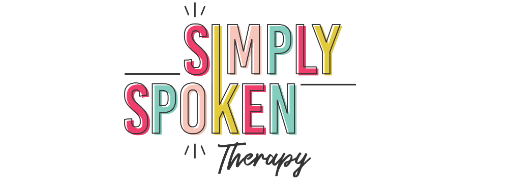5 Ways an SLP Can Help Your Child
Most people think about speech sounds when they hear the term ‘speech therapy’, but speech language pathologists, also known as SLP’S, can help with SO much more! We have developed a list of 5 ways a speech language pathologist is able to help your child with their communication skills.
♦Expressive Language Skills:
Expressive language is how your child communicates a thought, makes a request, or conveys a message to others. SURPRISE it’s not just speaking! We use gestures (pointing), vocalizations (crying and screaming), speaking, writing, and AAC (more on this below) to effectively communicate our wants and needs. For our youngest learners, language expression might be the number of words a child is using or how often they use them. For our older school-aged kids we might be looking at the pronouns they use, the organization of their sentence structures, or their ability to retrieve or find specific words needed for their message to be communicated clearly. An SLP is able to help determine a good starting point after an evaluation.
♦Speech Sound Intelligibility:
We have all been there….a child starts talking and you only understand a handful of their words and then you look to the parent to translate. THIS is speech intelligibility- how clear and intelligible are the words a child is using. The rule of thumb is that a 2 year old is 50% intelligible and a 3 year old is 75%. So, if your 3 year old says “tan we doe to duh pawk?” The message is clear, “can we go to the park” which demonstrates age-appropriate expressive language skills, but the clarity of their speech is reduced. Speech intelligibility can also play a role in a child’s early literacy and reading skills. If a child says “tat” for the word “cat” chances are they might try to spell it that way too. Both of these examples are children who could benefit from speech therapy to address the clarity of speech before they get frustrated or demonstrate any pre literacy issues. I like to refer to this chart from ASHA to help determine the more specific type of speech sound disorders.
♦Fluency/Stuttering
There are two types of stutters-typical and atypical. Between the ages of 3-5 many kids will experience moments of stuttering or disfluencies. This is because during this period of development kids are gaining TONS of skills. They are expanding their vocabulary, are able to say many more words, using different types of sentence structures, and are trying to organize their thoughts in real time. During this age range it is not uncommon to hear some whole word repetitions (can can can), some initial sound repetition (c-c-c-c-can) or even revisions and interjections (um, uh, ya know). It’s usually short lived (just a few weeks or months) and tends to be worse when kids are tired, excited, or fighting for attention. However, if there is a family history of stuttering, or the types of stuttering is filled with prolongations (cccccccccan), blocks (———–can), or physical movements (eye blinking, tightening of the body, head nodding), it might be time to contact a SLP to get some support.
♦Social Skills
Making and keeping friends is hard! Social skills are essential for communication, that’s why we have language! To communicate with others! We actually target social skills before we do ANY other language treatment. Surprising right?! In the youngest learners we call it Joint Attention- where two people are paying attention to the same thing, intentionally to interact socially. Think about babies, they giggle, coo, and light up when you are playing with them. This is how babies communicate socially! This article from UNC School of Medicine explains joint attention beautifully! Be sure to check it out. The social skills we address when kids are a bit older look much different. We target more abstract concepts of how to read body language, understand sarcasm, and problem solve social situations. Sometimes kids have a hard time understanding that thoughts and feelings are connected and their actions impact the thoughts and feelings of others. Making eye contact, understanding the size of the problem should match the size of the reaction, and the difference between your own plan and the group’s plan are very important concepts. If you have concerns with your child’s ability to use social and pragmatic language a SLP can help.
♦AAC
Augmentative and Alternative Communication is a way to help bridge the gap between what a child wants to say and what they are able to say. The first A in AAC is for Augmentative, which is for kids who need to supplement their natural speech. This can be with pictures, communication boards, gestures, sign language or choice boards. The second A in AAC is for Alternative, when a child needs a different way to communicate. This is where speech generating devices (SGD) and other output methods come into consideration and includes apps on a tablet, or stand alone devices. Regardless of what method you feel is best, it’s important to note that not all AAC methods are for each person. It’s like a prescription for glasses-not all prescriptions will work for all people. You have to find a therapist who understands the complexities of AAC and how to find the right method for your child.
Many people tend to be surprised by the variety of skills within the scope of practice for SLP’s. Our primary goal at Simply Spoke Therapy is to provide kids with the tools they need to be effective and confident communicators-simple as that! Whether you have a 2 year old who isn’t using enough words yet, or a 7 year old who struggles with social language and friendships, we are here to serve you. Use this link to contact us today!
Guest Blog submitted by Amanda Townsend at Simply Spoken Therapy

